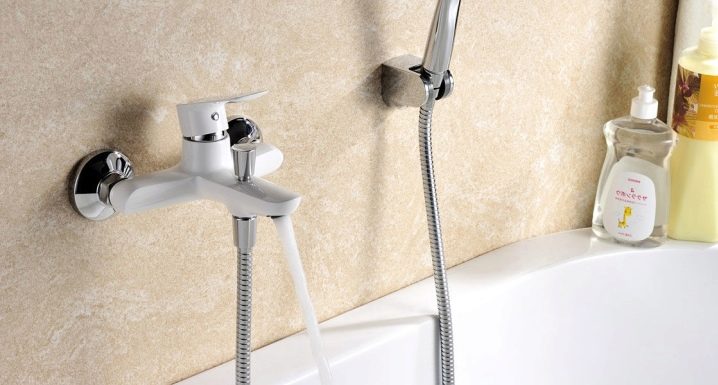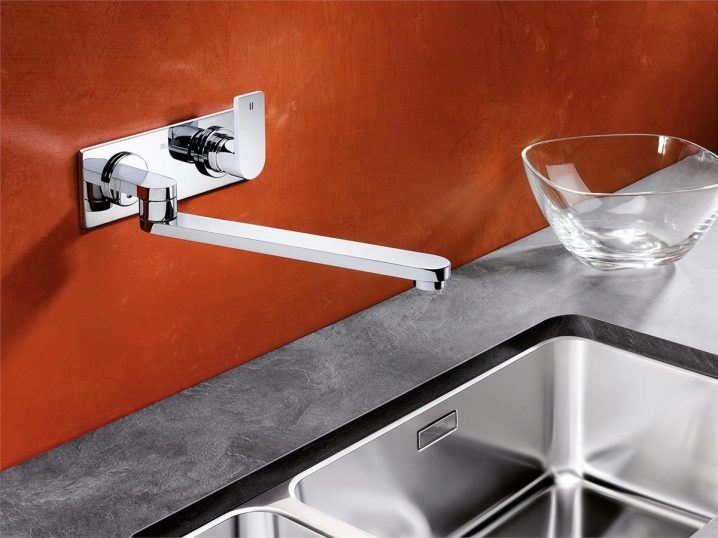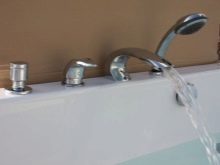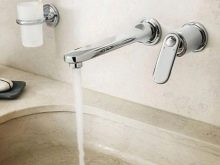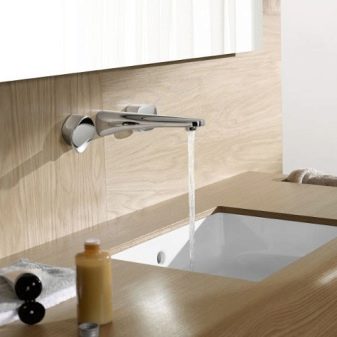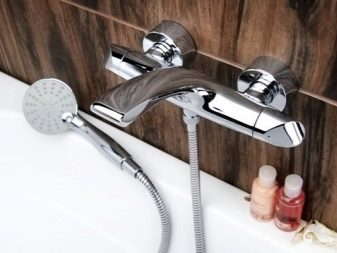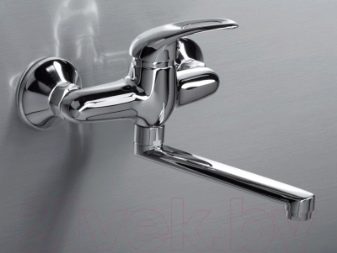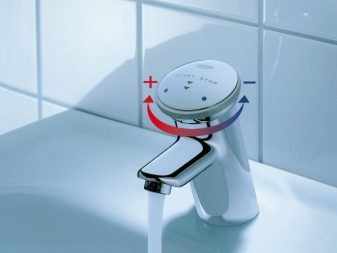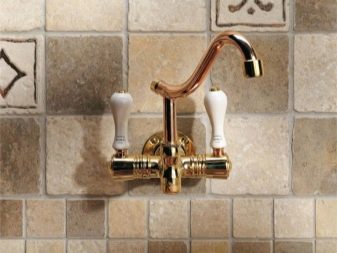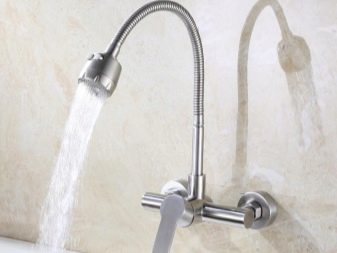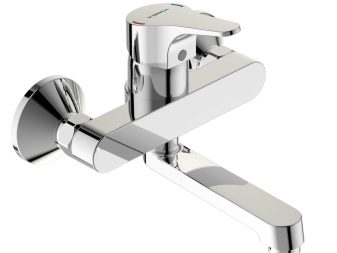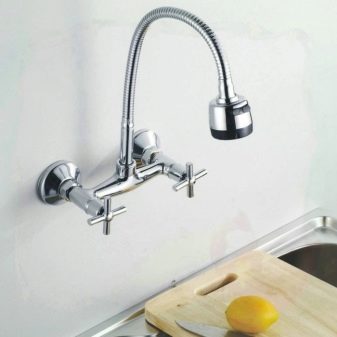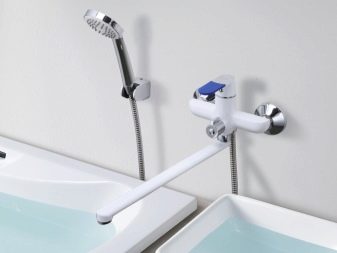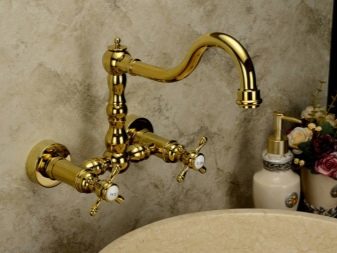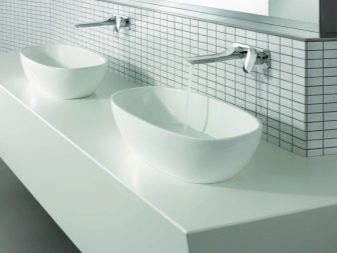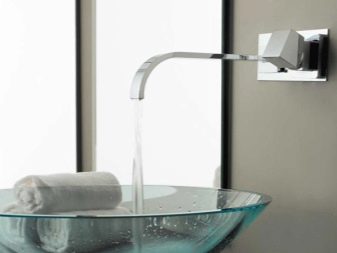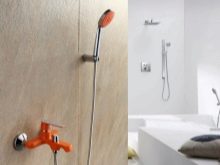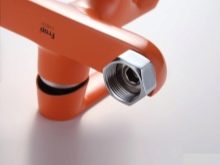Choosing a wall mixer
Repair is a very complicated and costly procedure. As a rule, during this process a lot of questions arise, and if the repair concerns the premises where water supply is required, their number increases many times. Our article is devoted to one of the most popular elements of plumbing - wall mixer.
Species
At the moment in the plumbing market there is a large selection of faucets for every taste and interior of a bathroom or kitchen. Consider how they are divided by place of installation.
- Embedded models. Mixers of this type are built into the design of the bath or sink. There are manufacturers who produce bathroom equipment already with a connector for mounting the mixer, where you just install the faucet.But such options are inconvenient because the entire structure of the water supply, pipes and other elements are fixed in the space under the sink and take up a lot of space.
- Wall models. Mixers of this type are mounted directly to the wall. In this case, all auxiliary structures remain in the wall, and it looks quite aesthetically pleasing and compact.
- Floor models. Their difference from the two previous mixers lies in the form and method of installation. The floor version is one or two racks, which are mounted directly on the floor, and the mixer itself is mounted on them.
Consider the most used and practical type of faucets - wall mounted. Like all of the above, it has a separation by the mechanism of mixing water before it is fed into the faucet. The setup speed and usability depend on it.
- Single lever. Such a mixer has in its design a locking mechanism in the form of a ball or a ceramic cartridge. In the first embodiment, a hollow steel ball is used, which has three holes, two of which are responsible for the supply of hot and cold water, and the third - the outlet for supplying mixed water directlyin the tap. The temperature is controlled by changing the diameter of the holes, which is controlled by the position of the lever.
- Two-valve. In this case, the locking mechanism may be in the form of either a ceramic valve or a tap. When the valve turns, the piston begins to act on the gasket, with the result that the hole opens slightly or closes the water supply. When the ceramic valve turns, the plate moves independently. This option is considered rather outdated, but it still does not lose its popularity to this day. All this is due to the rather low price and simple configuration mechanism.
- Portion. This design is driven by the button that the device contains. After pressing it for a short period of time, water flows into the faucet. Most often, this type of model is used in public places with the calculation of water savings.
Thermostats, electronic and other types of mixers are used extremely rarely, due to the high cost and complexity of designs.
Materials
In order for the mixer not to upset you and serve as long as possible, you must carefully approach the choice of material from which it will be made. Consider the most practical options.
- Brass. Considering the fact that various impurities may be present in the water, as well as lime deposits are possible, an alloy of copper and zinc becomes a good material for manufacturing. It is quite soft, but it is resistant to all of the above factors. It is also worth considering that at the present time there are almost no wall mixers consisting only of brass on the market, but the material is often used to create parts or, for example, directly for the body.
- Stainless steel. The use of this material is aimed at creating specific parts for adjusting water and fastening systems. Steel is rarely used as a material for the use of the hull, since it does not have durability.
- Chromium. This material, like brass, is very resistant to corrosion and impurities, and is also not subject to erosion when using modern cleaning products. This is one of the most environmentally friendly materials. Chromium is most often used either for coating or for the manufacture of the mixers themselves.
- Ceramics. Modern material, not subject to all types of corrosion, does not cause allergic reactions, is resistant to water and cleaning substances.
There are other materials used to make wall mixers, such as graphite, composite, etc.
How to choose?
For kitchen
Most of the time in the kitchen is spent just around the sink. That is why it is worth paying special attention to the choice of all its elements, including the wall mixer. When choosing a model, you must first decide on the design of the spout that you require. For example, if two sinks are placed in the kitchen, then a L-shaped or special shape is most suitable, and both versions should have a rotation angle of at least 140 degrees.
There are also models of mixers with such forms as traditional, arcuate and straight. Do not forget that faucets can have both short and long spouts. Their length usually varies, depending on the characteristics of use and customer requests.
Modern faucets can also include switches that supply water to the dishwasher or washing machine. And also there is the possibility of obtaining already filtered water from the tap. The kitchen version can be equipped with another novelty - the bottom valve, which allows one-touch to open or close the drain hole.
For bathroom
In any apartment, a bathroom is not just a room for maintaining body hygiene. Its interior should please the eye no less than the decor of any other room. Therefore, it is important to choose a mixer that will be harmoniously combined with other appliances and accessories.
Most wall-mounted bath mixers include a faucet and shower head (with flexible hose). They can be combined into a single structure or mounted on a wall separately. The most common option is a combined faucet for a bathtub and a sink; it includes one tap that can be rotated to the space in front of the sink or bathtub, as well as a watering can with a hose. This option is ideal for rooms with a very small area, it saves space and increases the functionality of its use.
Another interesting view is a wall mounted mixer. This is the same wall option, but with flush-mounted elements: on the surface it has only a lever for regulating water, a tap and a shower head, the hose of which is also hidden in the wall. This is the most modern and aesthetic appearance of the mixer.
Useful recommendations
- It is better to buy a mixer in specialized stores, there you can always get competent advice from the seller on the issue of interest to you.
- Before buying a mixer, it is necessary to measure all the most important plumbing parameters, for example, the width of the sink and the estimated height to which the device is to be installed. Then, when choosing, you will know exactly the desired length of the spout and approximately represent what kind of mixer you need.
- If you plan to install the mixer in a small room, and you have very limited space for installation, then you should think about buying a single-lever version with a side lever. This option is practical and takes up very little space.
- If you purchase a single-lever version, it is best to buy a filter with it, for example, coarse cleaning, otherwise the cartridge will last for a very short period of time.
- If the kitchen on which you want to install the faucet is not very large, then the wall version with a compact spout is more suitable for you. This model does not require a spacious sink and a large space.
- When buying a mixer, it is worth paying attention to whether the fastening system comes with it.The service life of wall-mounted mixers significantly increases if the fasteners are made of quality materials, as a rule, such fasteners are guaranteed.
- You should not save on the elements of plumbing, including faucets. But it is worth being careful when buying expensive models and be well acquainted with the instruction manual.
- Buying a mixer in the store, you should pay attention not to the cost of equipment, but to its weight. High-quality models made of brass are the most practical, but have more weight than the mixer of average quality.
If you have already decided on a wall-mounted washbasin or bath mixer and purchased it, the next step is to install it. The product itself can be cast or consist of collapsible parts. If the body is cast, then only levers, cartridges, taps and spouts are removed.
Prefabricated mixers have the greatest functionality., but the percentage of failure they have higher. Installing the faucet in the kitchen or in the bathroom does not require any additional skills from you, but you must make sure that the pipes, elbow or watering hose to which the appliance is attached are in good condition and reliability.In the bathroom very often install two-lever or single lever version with a hygienic shower.
As for the color range, chrome-plated mixers are considered the most popular, but you can choose more original models in the color of bronze, black, etc.
For how to install the wall mixer, see the following video.
